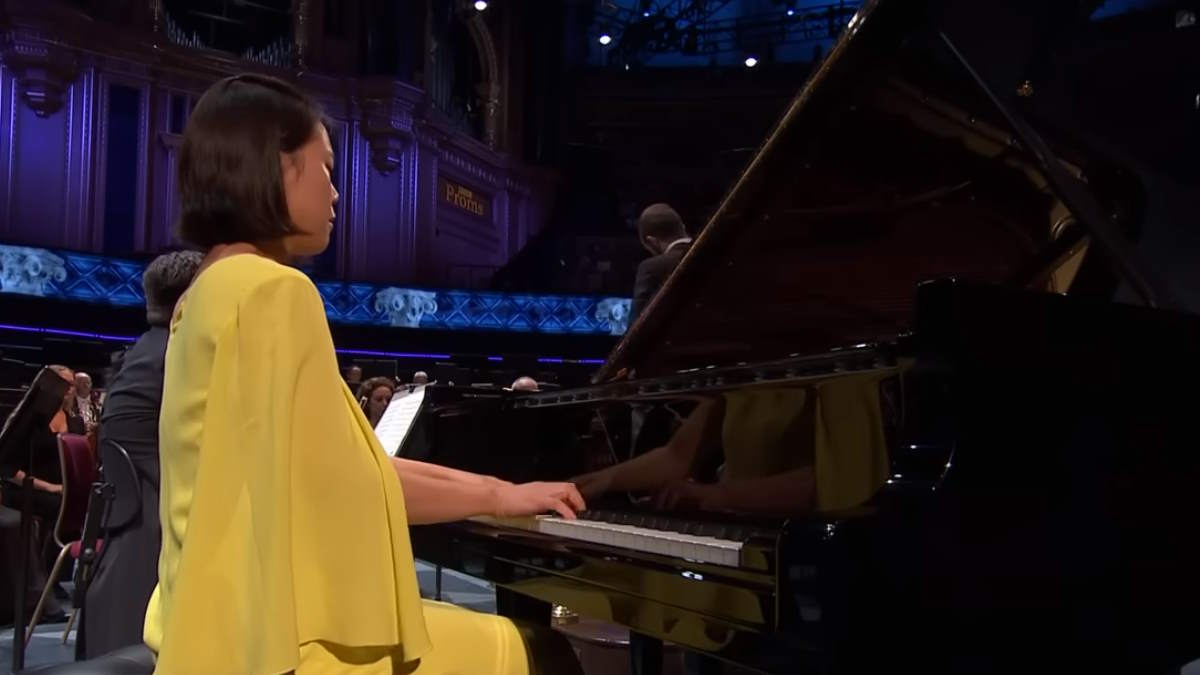Accompanied by the BBC Philharmonic Orchestra, world-renowned South Korean pianist Yeol Eum Son performs Wolfgang Amadeus Mozart’s Piano Concerto No. 15 in B-flat major, KV. 450. Conductor: Omer Meir Wellber. This performance was recorded during the BBC Proms on July 26, 2019.
Wolfgang Amadeus Mozart’s Piano Concerto No. 15
Mozart’s Piano Concerto No. 15 in B-flat major, K. 450, composed in 1784, is a work that shines with clarity and inventiveness, demonstrating Mozart’s maturing style and confidence in handling the concerto form. This concerto is notable for its intricate and sophisticated interplay between the piano and the orchestra, marking a significant development in Mozart’s compositional approach towards a more integrated and dialogic structure compared to his earlier concertos.
Created during a particularly productive period of Mozart’s life in Vienna, Piano Concerto No. 15 is characterized by its bright and energetic spirit. Mozart himself regarded this piece with a special fondness, considering it a significant leap forward in his artistic development. He wrote this concerto for his own performance, which perhaps explains the virtuosic demands placed on the soloist, showcasing a wide range of expressive possibilities – from lyrical passages to brisk, technically challenging sections.
Movements
1. Allegro
The first movement of Mozart’s Piano Concerto No. 15 in B-flat major, K. 450, is marked as “Allegro,” and it beautifully exemplifies Mozart’s mastery in the classical concerto form. This movement is vibrant and full of energy, featuring a richness in thematic material and an intricate interplay between the solo piano and the orchestra.
Structured in sonata-allegro form, the movement begins with an orchestral exposition that introduces the main thematic ideas. These themes are characterized by their lyrical quality and rhythmic vitality, setting the stage for the piano’s entrance. When the piano enters, it does not merely mimic the orchestra’s themes but expands on them, adding new dimensions and demonstrating Mozart’s innovative approach to the concerto format.
The development section of the movement is where Mozart particularly shines, as he manipulates and explores the themes introduced earlier. This section is marked by modulations and explorations of different keys, providing a dramatic contrast to the exposition. The piano and orchestra engage in a spirited dialogue, showcasing the soloist’s virtuosity and the compositional complexity that Mozart could achieve.
The recapitulation brings back the main themes, now adorned and altered, integrating the solo piano and the orchestra in a more profound synthesis. This culminates in a cadenza, typically improvised by the performer in Mozart’s time, allowing the soloist to display technical prowess and interpretative skills before the orchestra rejoins for a spirited conclusion.
2. Andante
The second movement of Mozart’s Piano Concerto No. 15 in B-flat major, K. 450, is marked “Andante.” This movement shifts the mood from the energetic and vibrant first movement to one of serene beauty and lyrical depth. It serves as a delicate and expressive contrast, showcasing Mozart’s ability to craft sublime and emotive slow movements.
In this Andante, the orchestration is subdued, allowing the piano to take center stage with its expressive melodic lines. The music flows gently, with the piano weaving through tender and elegant passages that highlight its lyrical capabilities. The orchestral accompaniment is restrained yet harmonically rich, creating a soft cushion that enhances the soloist’s performance without overshadowing it.
Mozart’s use of subtle dynamic shifts and the intimate interplay between the piano and the orchestra lend this movement a reflective and introspective quality. The themes are developed with a quiet intensity that maintains the listener’s engagement, drawing them deeper into the emotional landscape of the concerto.
The movement’s structure is simple yet effective, focusing on the beauty of the melodic content and the purity of expression, rather than on complex development or thematic transformation. This approach allows the Andante to unfold as a moment of calm and contemplation within the broader dynamic scope of the concerto.
3. Allegro
The third movement of Mozart’s Piano Concerto No. 15 in B-flat major, K. 450, is marked “Allegro,” and it provides a lively and spirited conclusion to the concerto. This movement, a rondo, captures Mozart’s characteristic blend of playful elegance and technical brilliance.
Structured around a recurring principal theme, the rondo format of this movement allows for a series of contrasting episodes that alternate with the main theme. The principal theme is catchy and upbeat, characterized by its rhythmic vitality and melodic charm. Each time it returns, it brings a sense of familiarity and structural coherence to the movement.
The contrasting episodes explore different moods and showcase the piano’s agility and expressive range. These sections include rapid passages, intricate runs, and dynamic contrasts, providing the soloist opportunities to display both technical prowess and interpretative finesse. The interplay between the piano and orchestra remains vibrant and engaging, with the orchestral parts complementing and occasionally dialoguing with the piano’s lines.
Mozart concludes the concerto with a flourish, as the final return of the rondo theme leads into a joyful and energetic coda. This concluding section sums up the exuberance of the movement and ends the concerto on a high note, leaving the audience with a sense of exhilaration and admiration for the composer’s inventive musicality.
Sources
- Piano Concerto No. 15 (Mozart) on Wikipedia
- Piano Concerto No. 15 in B-flat major, K.450 (Mozart, Wolfgang Amadeus) on the International Music Score Library Project website
- Mendelssohn: Symphony No. 3 [Paavo Järvi, Tonhalle-Orchester Zürich] - May 16, 2024
- Brahms: Symphony No. 1 [Haifa Symphony, Bar Avni] - May 16, 2024
- Bach: Goldberg Variations [András Schiff] - May 15, 2024
